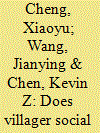| Srl | Item |
| 1 |
ID:
186620


|
|
|
|
|
| Summary/Abstract |
How do cadres provisionally and strategically dispatched from superior governments interact with different rural elites to implement national policy in China? This article examines the case of Targeted Poverty Alleviation (TPA) program to illustrate the mechanism of national policy implementation in rural areas within current China's bureaucracy change and emergence of new elites in villages. Two mechanisms have been detected: the division of work between sent-down cadres and village cadres, and the cooptation of new elites by sent-down cadres. Specifically, the sent-down cadres make use of economic and political resources and institutions to co-opt economic elites and skilled talents that could be seen as new elites in villages during the TPA period. Therefore, this study reveals that the structural change in contemporaty rural China under TPA program affects policy implementation and new elites play a vital role in strengthening national policy implementation. This study contributes to the theoretical knowledge on the rural elites' effect on policy implementation by highlighting the cooptation mechanism of dispatched cadres as an evolution of bureaucracy. This pattern seems to be the "soft intervention" to the Chinese rural society. The findings imply that the state as an adaptive mechanism remains historical legacies in the implementation of state policies.
|
|
|
|
|
|
|
|
|
|
|
|
|
|
|
|
| 2 |
ID:
187803


|
|
|
|
|
| Summary/Abstract |
Poor targeting performance is a common concern in the increasingly implemented decentralized targeted antipoverty programs in developing countries. Different from previous literature that focuses on targeting errors caused by elite capture, we explore the role of villager social capital as a whole in poverty targeting in the context of China's Targeted Poverty Alleviation (TPA) policy. The empirical analysis uses a unique census-type data from three administrative and seventeen natural villages in the poverty-stricken county in Western China in 2017. Villager social capital is measured by a proxy index by combing reciprocity, support time, gift expenses, and political connection of villagers. We verify that the villager with rich villager social capital is more likely to be a beneficiary of TPA by using instrumental variable estimation. The nonpoor can mobilize their higher level of social capital than the poor to capture the beneficiary quotas that should be allocated to the poor, resulting in mistargeting. Such effect persists after controlling political elite capture effects. The findings point out villager social capital is the root cause of poor targeting in decentralized targeting programs in rural China and also lend new support from China to the classic debate on social capital is not the capital of the poor.
|
|
|
|
|
|
|
|
|
|
|
|
|
|
|
|
| 3 |
ID:
177125


|
|
|
|
|
| Summary/Abstract |
With the implementation of the Policy of “Targeted Poverty Alleviation” in 2013, China has been in the critical stage to fight against poverty and the county economy has entered into a new stage of development which presents new evolutionary characteristics. However, traditional poverty county assessments are mostly based on the economic census, which not only costs a lot of manpower and material resources, but also shows the feature of hysteresis and scarcity. In this paper, county-level electricity consumption data is adopted to explore the characteristics of China's county-level economy development based on BIRCH clustering since electricity consumption data can be more sensitive and objective in reflecting regional economic development and residents' income level. The results show that four kinds of county-level economic development patterns can be categorized in China with different industrial structures. Then the potential problems with different development patterns are explored and suitable policy suggestions for each pattern is proposed separately. It can be found that electricity consumption should be a useful auxiliary tool for economic development assessment and monitoring for China and other similar developing countries.
|
|
|
|
|
|
|
|
|
|
|
|
|
|
|
|